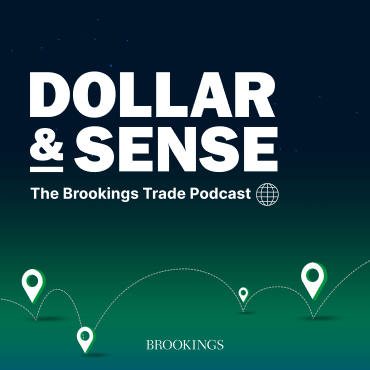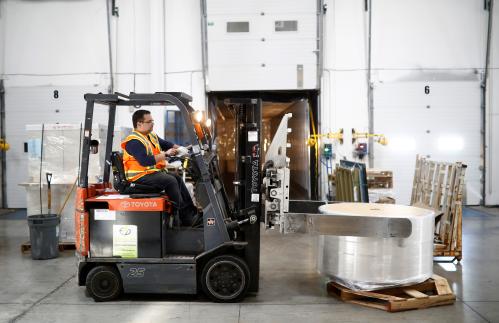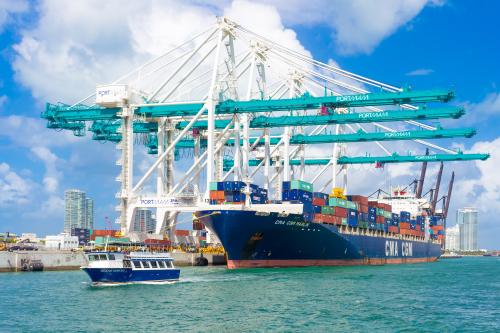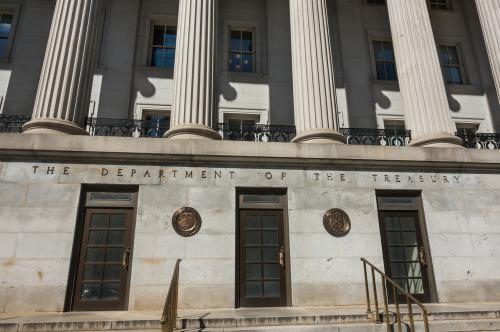In this episode of Dollar & Sense, we flip the format and ask host David Dollar what new data can tell us about how the COVID-19 pandemic and the associated recession are affecting U.S. trade. Dollar shares insights on which industries have been hit hardest, how the recession will alter the U.S. trade deficit and the phase one trade deal with China, and the likelihood American companies begin reshoring their manufacturing and value chains.
Related content
How will COVID-19 reshape America’s logistics workforce?
More Brookings research on COVID-19
NEWBY: Hi, I’m Anna Newby, guest hosting today on the Brookings trade podcast Dollars & Sense. I’m here with David Dollar himself, the typical host for the podcast, to get his thoughts on what we know at this stage about how the COVID-19 pandemic has affected global trade.
Welcome, David, to the other side of our virtual interview table today.
DOLLAR: It’s a great pleasure to talk to you, Anna.
NEWBY: So the U.S. publishes very detailed trade statistics in terms of products and partners. They just came out with data through the first half of 2020 providing a snapshot on the effects of the coronavirus pandemic and the associated economic recession on U.S. trade. So, my first question just has to do with trade imbalances. It looks like the overall U.S. trade deficit is contracting modestly this year. Can you explain why that would be happening?
DOLLAR: So the coronavirus recession is affecting both U.S. imports and U.S. exports. For the moment, it’s having a somewhat stronger effect on imports. We import quite a bit more than we export, so if they both go down by a similar percentage, imports actually go down more in U.S. dollars. And, frankly, the recession is more serious in the United States than in some of our trading partners. We can get into talking about some specific trading partners, but in general, the recession is worse here, so the compression of imports is greater than the decline in exports. But I wouldn’t get too excited. I think in the first half of the year the trade deficit went down by about 20 billion dollars. That’s basically a rounding error in our GDP, so I wouldn’t get too excited. The other thing I would say is we don’t really want the trade deficit to go down because we’re in a serious recession. As we come out of recession, probably our trade balance will go back to about where it was. It’s been about three percent of GDP, that deficit, for a few years. Most economists are not too worried about that.
NEWBY: Okay, got it. Thanks. That’s really helpful for context. So let’s talk about the export side. How are American exports holding up right now?
DOLLAR: Overall, exports in the first half of the year were down 16 percent compared to last year. That’s more of a decline than we’ve seen in GDP. I think that’s common in recessions as trade is often more effected than many other parts of the economy. Looking at the U.S. detailed data—and let me just say, as an economist, I really appreciate the quality of U.S. statistics on many different issues, including international trade. So we have an amazing amount of data.
One thing that jumps out at me is that 16 percent decline is just spread very unevenly across goods and services. So I’ll give you a few examples. The U.S. is a major exporter of services. One of the major ones is all the foreigners who come to the U.S. as tourists or students. So what they spend on international travel, and then they come here, lodging, meals, going to Disneyland, going to Harvard… those are all exports of services by the United States. So, that’s down about 50 percent, and that’s a pretty remarkable number in economics — to see something, a big category, decline by 50 percent. I think that’s not that surprising. We’ve cut off international travel, universities are not clear if they’re opening, entertainment, et cetera, et cetera. But we export some other important services as well. Financial services and telecommunication services are two big exports. And I was struck that they are at about the same level as last year. So they’re not growing, but they’re not declining. So you’ve got this tremendous unevenness.
We see the same thing in manufacturing. Two of our big exports, aircraft and automobile parts, are down 30 to 40 percent. Again, I think it makes sense. Airlines all over the world are cutting back their expansion plans. People are holding off on big purchases for things like autos. So those numbers are down. On the other hand, semiconductors, which has been in the news a lot — we’re trying to restrict our semiconductor sales to Huawei, the Chinese telecom company. Well, overall, our semiconductors exports went up by 12 percent in the first half of the year. And I think that partly reflects that Asia is recovering pretty quickly from the recession. And, despite headlines about one company, we export a lot of semiconductors.
And then just briefly if I could add one more thing because we are such a diversified exporter: agriculture is a major export, and that’s down about three percent. Of course that’s not good—that’s down. But compared to some of those other numbers I was mentioning, agriculture is holding up pretty well because people have to eat and we’re a major supplier of food. So the basic point there, Anna, is tremendous variation across different goods and services in response to this virus.
NEWBY: Thanks. That all makes a lot of sense. So let’s turn to the other side of the balance sheet and look at imports. How are imports being affected?
DOLLAR: Right. So we’ve had a pretty serious compression of imports. And again, it tends to be concentrated in some specific areas. It’s no surprise our imports of crude oil are down by about 40 percent. People are driving a lot less. Like, I hardly use my car anymore. I’ve been wondering maybe I should stop paying insurance or maybe sell off the car since I never drive it anymore. And the quick statistics that come out are in current U.S. dollars, so that decline is a reflection that we’re importing a lot less oil. Plus, the price went down quite a lot. So what we’re spending on oil is down very dramatically.
I was also curious to see that things like auto imports are way down. We have this integrated auto production with Canada and Mexico, so we both export and import. They’re both down, and I think that reflects the reality that sales pretty much everywhere are down. But also cell phones and televisions—our imports are down about 25 percent. And pretty much all the televisions and cell phones used in the U.S. are imported. So that’s a pretty good indication about the whole market.
I thought perhaps some people were sitting at home ordering plasma TVs in order to make lock down a little bit more pleasant. And I’m sure some of that’s happening, but on average, people are holding off on these big ticket items, probably reluctant to go out to retailers. And also, everybody’s worried about their income. What’s going to happen? So you hold off on the big purchases and then that’s reflected pretty dramatically. Then on the other side of the ledger, our imports of medical equipment are holding up and imports of pharmaceuticals are up about 15 percent. So this kind of crisis is always going to create some opportunities for particular industries and it’s going to create really serious problems for some of the sectors I’ve mentioned.
NEWBY: Got it. Thanks. It’s interesting to sort of look at the nuances sector-by-sector on that. So what about trade with particular countries, David? Are there certain stories that we should be watching there in terms of international trade?
DOLLAR: It is interesting how our trade with different partners is playing out. Our imports from China are down pretty dramatically. We import a lot from China. A lot of those consumer products. I mentioned some products that are down. So not surprisingly, our imports from China are down by about 20 percent. And we have had that trade war going on. While we reached a phase one trade deal, we left most of our tariffs in place. So we’re tariffing about half of our imports from China at 25 percent. So that has to be one factor. And then you’ve got the recession on top. So I found it interesting that our imports from China, Mexico, Canada — these are, in fact, our three biggest trade partners — they’re all down about 20 percent. To be honest, I think the recession is a lot more important than the trade war. Some important products like cell phones are not covered by those tariffs that I mentioned. In some cases, retail firms just absorb these losses, basically. So, I doubt the trade war has had that much effect, but the recession clearly had a very large effect on what we’re importing from these different countries.
If you look at the export side, again with Canada and Mexico, and those are our two biggest partners, our exports are down about 20 percent. I think this just reflects this serious recession throughout all of North America. But in the first half of the year, our exports to China were only down five percent. So that’s down, but still that’s a pretty modest number, and I think it reflects China recovering from this recession relatively quickly. They actually posted a positive growth number in the second quarter, so they’re recovering more quickly. And then we do have this phase one trade agreement. We can talk a little bit more about that, but I think they are making an effort to import more from the U.S.
NEWBY: Yeah, let’s zero in on the question of the U.S.-China trade war and the trade deal where we already have a phase one. You see in the data that U.S. exports to China are a relative bright spot. They’re down, but they’re down only five percent, which, as you’ve described, sort of relative to other areas is somewhat smaller. So the broader efforts around a U.S.-China trade deal seem really relevant here. Phase one of that deal was supposed to bring an increase in U.S. exports to China. So, what’s happening there, and what are the prospects for the deal at this point?
DOLLAR: So I think the situation creates an interesting dilemma for President Trump and his administration. Our exports to China, as we just discussed, are actually down. News is not as much as our exports to many other partners, but still down. But China is recovering from their recession. If you just focus on June, our exports were actually up compared to a year ago. So that trend is in a positive direction. But they are supposed to be importing a lot more from the U.S. That phase one agreement had specific targets that were relative to 2017 trade levels. So, frankly, our exports are far below the 2017 level. I mean, not to throw too many numbers, but a simple way to think about it is that we’re at about half the level of exports that would meet the target for this phase one trade deal.
So some of President Trump’s China hawk advisors are encouraging him to rip up the deal and basically argue that China is not getting close to meeting those targets. On the other hand, U.S. Trade Representative Lighthizer and his Chinese counterpart Lie He are going to have a video meeting on August 15th to review progress. And I think you’ve got, first what we’ve emphasized, a relative bright spot in global trade compared to other things. Plus, if you look at the specifics of the deal, some elements of it are just clearly impossible. We were supposed to increase exports of a wide range of goods and services, including those travel-related services I mentioned. But we don’t have flights coming in from China. We don’t have students coming in from China. There’s just no way that particular element can increase during 2020—seems unlikely 2021. We were supposed to export 25 billion dollars of energy this year but prices are down, demand is down, the U.S. industry is contracting. So you’ve got elements of the deal that are just really hard to take seriously in the current environment. On the other hand, I mentioned the overall U.S. ag exports were holding up fairly well, but not increasing to China yet. So I would guess at that August 15th meeting there would be a lot of discussion about where are areas where China can increase its purchases, particularly in agriculture.
Then the dilemma the administration faces: do you want to accept a good situation in a terrible global recession environment, or do you want to tear up the deal which might appeal to some of President Trump’s base? On the other hand, probably stock markets will not react well to tearing up the deal because there was a lot of concern about the rising protectionism in the U.S. and the U.S.-China trade war. And if that seems to be getting worse, that’s probably going to complicate our recovery. So I think it’s a difficult decision. And frankly, there’s no particular reason why the president needs to make the decision in the next week or two as far as I can see. He may very well wait as this summit proceeds to see if there’s more agricultural exports to China. Then there’s plenty of time before November to decide if he wants to ratchet up the trade war.
NEWBY: Well, that’s definitely a story that we will continue to watch. I have one last question for you, David, and that’s about American manufacturing. There’s a lot of talk of reshoring of manufacturing in the U.S. and driving value chains out of China. Do we see any evidence in the data that this is happening?
DOLLAR: I would respond by emphasizing that there are all different types of value chains. There’s kind of a joke in the business that if you’ve seen one value chain, you’ve seen one value chain. They are all very, very different. So some of this discussion has a certain model behind it, I think. Some of the discussion is assuming that there’s a lot of American manufacturing capacity that’s moved to China to produce things to sell back to the United States. But I would argue that that’s actually quite rare. It’s hard to find American investors who’ve gone to China in order to export from China. They’re basically in China to serve the domestic market. Our auto companies would be one of the best examples of that. They’re not exporting any cars out of China back to the U.S. They have a certain amount of components that go from the U.S to China, they assemble in China, and they sell into the Chinese market. And actually, that Chinese auto market is starting to grow again as they’ve come out of their recession. So most of the American producers in China are there for the domestic market.
The American Chamber of Commerce did a recent poll of their members to see if they were thinking of leaving China, and I believe over 80 percent had no thoughts about moving any production out of China. So, if we did ratchet up the trade war between the U.S. and China, I wouldn’t expect that production to move back to the U.S. That doesn’t make sense. If anything, you might have the opposite effect that producers might worry about bringing American content into their Chinese production. So you might get separation, but in some sense in a bad way where there would be less U.S. content.
Now, it is true there is quite a bit of production in China for export to the U.S. Not so much by American companies, but more commonly by Korean, Japanese, and Taiwanese companies. That’s where a lot of our popular electronics and cameras, televisions, these kind of products. There I do think we’re seeing some shift in value chains, but not to bring things back to the United States because it’s just simply not economic to produce these products in the United States. What we’re seeing is some shift of what I call final assembly out of China and to lower-wage countries, mostly in Southeast Asia. Vietnam is the poster child for this. So over the last year or so you’ve seen a big increase in Vietnam’s exports to the United States of these electronic products. But then if you go deeper into the value chain, China has moved into the middle of the value chain producing machinery and components. So China’s exports to Vietnam have gone up very dramatically. So if you kind of look at the effect of the trade war on these kind of products, it’s been this shift of a certain amount of final assembly to Indonesia, Vietnam, et cetera. China is still providing a lot of the content from terms of machinery and more sophisticated components. And actually, a lot of those producers in Vietnam and Indonesia are Chinese firms. So you are getting some reshaping of value chains, but not in a way that brings production back to the U.S.
The last thing I would say on this, Anna, is that thinking about the diversity of products is actually quite helpful because there are some things that are clearly related to national security. First, we’ve always produced our military equipment domestically. We may decide that there’s certain pharmaceuticals or other types of high-tech components. We could create incentives to produce some of these things in the U.S. There will be a cost in the sense that if they’re not being produced now it’s because it’s more efficient to produce them somewhere else. So I think we want to be careful in what we want to delineate. We don’t want to try to get everything to be produced in the U.S. because that’s going to end up being very, very costly. But we could have a careful look at which kinds of value chains we’d like to see in the United States.
So I just think it’s a really complicated area where we probably could get some reshoring of critical national security inputs, but that’s going to end up being a tiny part of the economy. Then the notion that we’re going to get value chains in any large sense to leave China, that doesn’t really make sense to me because a lot of the production is for the Chinese market. And then you’re looking at exports. You’ve got integrated value chains across Asia, and China just has to move into the middle, have final assembly in those other countries. Then whatever the U.S. is doing with tariffs is not going to be that relevant, frankly. So I’ve never been a big fan of this tariff strategy in terms of trying to change our trade relations with China.
NEWBY: Well, it’s been a real pleasure talking to you, David. And as a total lay person myself on this subject, I can say that I certainly learned a lot.
DOLLAR: Well, thank you, Anna. I know we got a little nerdy there with all the data. You see a lot of anecdotes in the press, and I think a good anecdote can be valuable for giving you context, but it’s always dangerous to generalize from a couple of anecdotes. So I like to look at the data in terms of what’s actually happening. And I think the reality of trade and foreign investment is that these things change a lot more slowly than you might think. So when you read something that’s not just the U.S. — Japan is making some effort to encourage its companies to diversify out of China. I’m sure that will have a small effect, but at the end of the day, it’s not going to have a very big effect.
NEWBY: Well, I’m all for getting nerdy every once in a while. So let me just say thanks to all of our listeners and tune in again in two weeks when David will be back in the interviewer seat. If you haven’t already, make sure to subscribe on Apple Podcasts or wherever else you get your podcasts. Dollars and Sense is part of the Brookings Podcast Network. It wouldn’t be possible without the support of Shawn Dhar, Fred Dews, Chris McKenna, Gastón Reboredo, Camilo Ramirez, Emily Horne, and many more. If you like the show, please make sure to read it and leave us a review. Send any questions or episode suggestions to [email protected].
The Brookings Institution is committed to quality, independence, and impact.
We are supported by a diverse array of funders. In line with our values and policies, each Brookings publication represents the sole views of its author(s).









Commentary
PodcastHow is COVID-19 affecting US trade?
August 10, 2020
Listen on
Dollar and Sense Podcast